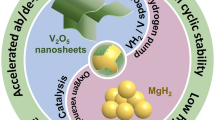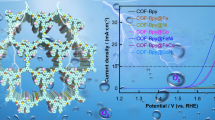Abstract
A facile preparation method was developed to obtain two-dimensional (2D) metal-free N, P-co-doped carbon nanosheets with sp2/sp3 interface derived from polymerizable ionic liquids (PIL) and ammonium nitrate (NH4NO3), exhibiting better electrocatalytic activity than that of the commercial Pt/C toward oxygen reduction reaction (ORR). The introduction of NH4NO3 can benefit the formation of carbon nanosheets structure and hierarchical porous structure due to decomposition and carbonization of polymer and gases emission resulting from ammonia nitrate, which can be confirmed by the SEM, TEM and BET results. The sp3 carbon and doping effect of heteroatoms of N, P can be investigated with the XPS, Raman and NEXAFS spectroscopy. The present work developed a facile method to prepare heteroatom-co-doped carbon as metal-free catalyst toward ORR with superior catalytic performance.
Graphic abstract
Two-dimensional carbon nanosheets doped with N, P atoms can be successfully prepared via pyrolysis process of the polymerizable ionic liquids ([Hvim]DHP) and NH4NO3, demonstrating superior electrocatalytic performance toward oxygen reduction in alkaline media.






Similar content being viewed by others
References
Cano ZP, Banham D, Ye S, Hintennach A, Lu J, Fowler M, Chen Z (2018) Batteries and fuel cells for emerging electric vehicle markets. Nat Energy 3:279–289. https://doi.org/10.1038/s41560-018-0108-1
Cheng F, Chen J (2012) Metal–air batteries: from oxygen reduction electrochemistry to cathode catalysts. Chem Soc Rev 41:2172–2192. https://doi.org/10.1039/C1CS15228A
Yin Z, Lin L, Ma D (2014) Construction of Pd-based nanocatalysts for fuel cells: opportunities and challenges. Catal Sci Technol 4:4116–4128. https://doi.org/10.1039/C4CY00760C
Rabis A, Rodriguez P, Schmidt TJ (2012) Electrocatalysis for polymer electrolyte fuel cells: recent achievements and future challenges. ACS Catal 2:864–890. https://doi.org/10.1021/cs3000864
Watanabe M, Tryk DA, Wakisaka M, Yano H, Uchida H (2012) Overview of recent developments in oxygen reduction electrocatalysis. Electrochim Acta 84:187–201. https://doi.org/10.1016/j.electacta.2012.04.035
Shao M, Chang Q, Dodelet J-P, Chenitz R (2016) Recent advances in electrocatalysts for oxygen reduction reaction. Chem Rev 116:3594–3657. https://doi.org/10.1021/acs.chemrev.5b00462
Shao Y, Dodelet JP, Wu G, Zelenay P (2019) PGM-free cathode catalysts for PEM fuel cells: a mini‐review on stability challenges. Adv Mater 31:1807615. https://doi.org/10.1002/adma.201807615
Gewirth AA, Varnell JA, DiAscro AM (2018) Nonprecious metal catalysts for oxygen reduction in heterogeneous aqueous systems. Chem Rev 118:2313–2339. https://doi.org/10.1021/acs.chemrev.7b00335
Dai L, Xue Y, Qu L, Choi HJ, Baek JB (2015) Metal-free catalysts for oxygen reduction reaction. Chem Rev 115:4823–4892. https://doi.org/10.1021/cr5003563
Zheng Y, Jiao Y, Jaroniec M, Jin Y, Qiao SZ (2012) Nanostructured metal-free electrochemical catalysts for highly efficient oxygen reduction. Small 8:3550–3566. https://doi.org/10.1002/smll.201200861
Wu G, Santandreu A, Kellogg W, Gupta S, Ogoke O, Zhang H, Wang H-L, Dai L (2016) Carbon nanocomposite catalysts for oxygen reduction and evolution reactions: from nitrogen doping to transition-metal addition. Nano Energy 29:83–110. https://doi.org/10.1016/j.nanoen.2015.12.032
Gong K, Du F, Xia Z, Durstock M, Dai L (2009) Nitrogen-doped carbon nanotube arrays with high electrocatalytic activity for oxygen reduction. Science 323:760–764. https://doi.org/10.1126/science.1168049
Wang Y, Li J, Wei Z (2018) Recent progress of carbon-based materials in oxygen reduction reaction catalysis. ChemElectroChem 5:1764–1774. https://doi.org/10.1002/celc.201701335
Daems N, Sheng X, Vankelecom IF, Pescarmona PP (2014) Metal-free doped carbon materials as electrocatalysts for the oxygen reduction reaction. J Mater Chem A 2:4085–4110. https://doi.org/10.1039/C3TA14043A
Zhang J, Zhao Z, Xia Z, Dai L (2015) A metal-free bifunctional electrocatalyst for oxygen reduction and oxygen evolution reactions. Nat Nanotechnol 10:444–452. https://doi.org/10.1038/nnano.2015.48
Xiang Z, Cao D, Huang L, Shui J, Wang M, Dai L (2014) Nitrogen-doped holey graphitic carbon from 2D covalent organic polymers for oxygen reduction. Adv Mater 26:3315–3320. https://doi.org/10.1002/adma.201306328
Yang Q, Zhang Z, Sun X-G, Hu Y-S, Xing H, Dai S (2018) Ionic liquids and derived materials for lithium and sodium batteries. Chem Soc Rev 47:2020–2064. https://doi.org/10.1039/C7CS00464H
Paraknowitsch JP, Zhang J, Su D, Thomas A, Antonietti M (2010) Ionic liquids as precursors for nitrogen-doped graphitic carbon. Adv Mater 22:87–92. https://doi.org/10.1002/adma.200900965
Yang W, Fellinger T-P, Antonietti M (2011) Efficient metal-free oxygen reduction in alkaline medium on high-surface-area mesoporous nitrogen-doped carbons made from ionic liquids and nucleobases. J Am Chem Soc 133:206–209. https://doi.org/10.1021/ja108039j
Qian W, Texter J, Yan F (2017) Frontiers in poly(ionic liquid)s: syntheses and applications. Chem Soc Rev 46:1124–1159. https://doi.org/10.1039/C6CS00620E
Gao J, He C, Liu J, Ren P, Lu H, Feng J, Zou Z, Yin Z, Wen X, Tan X (2018) Polymerizable ionic liquid as a precursor for N, P co-doped carbon toward the oxygen reduction reaction. Catal Sci Technol 8:1142–1150. https://doi.org/10.1039/C7CY02268A
Gao J, Ma N, Zhai J, Li T, Qin W, Zhang T, Yin Z (2015) Polymerizable ionic liquid as nitrogen-doping precursor for Co–N–C catalyst with enhanced oxygen reduction activity. Ind Eng Chem Res 54:7984–7989. https://doi.org/10.1021/acs.iecr.5b01703
Gao J, Ma N, Zheng Y, Zhang J, Gui J, Guo C, An H, Tan X, Yin Z, Ma D (2017) Cobalt/nitrogen-doped porous carbon nanosheets derived from polymerizable ionic liquids as bifunctional electrocatalyst for oxygen evolution and oxygen reduction reaction. ChemCatChem 9:1601–1609. https://doi.org/10.1002/cctc.201601207
Gao J, Wang Y, Wu H, Liu X, Wang L, Yu Q, Li A, Wang H, Song C, Gao Z, Peng M, Zhang M, Ma N, Wang J, Zhou W, Wang G, Yin Z, Ma D (2019) Construction of a sp3/sp2 carbon interface in 3D N-doped nanocarbons for the oxygen reduction reaction. Angew Chem Int Ed 58:15089–15097. https://doi.org/10.1002/anie.201907915
Lv J-J, Li Y, Wu S, Fang H, Li L-L, Song R-B, Ma J, Zhu J-J (2018) Oxygen species on nitrogen-doped carbon nanosheets as efficient active sites for multiple electrocatalysis. ACS Appl Mater Interfaces 10:11678–11688. https://doi.org/10.1021/acsami.8b00240
He X, Ma H, Wang J, Xie Y, Xiao N, Qiu J (2017) Porous carbon nanosheets from coal tar for high-performance supercapacitors. J Power Sources 357:41–46. https://doi.org/10.1016/j.jpowsour.2017.04.108
Zhang J, Qu L, Shi G, Liu J, Chen J, Dai L (2016) N, P-codoped carbon networks as efficient metal-free bifunctional catalysts for oxygen reduction and hydrogen evolution reactions. Angew Chem Int Ed 55:2230–2234. https://doi.org/10.1002/ange.201510495
Li Y, Zhou W, Wang H, Xie L, Liang Y, Wei F, Idrobo J-C, Pennycook SJ, Dai H (2012) An oxygen reduction electrocatalyst based on carbon nanotube–graphene complexes. Nat Nanotechnol 7:394. https://doi.org/10.1038/nnano.2012.72
Liang Y, Li Y, Wang H, Zhou J, Wang J, Regier T, Dai H (2011) Co3O4 nanocrystals on graphene as a synergistic catalyst for oxygen reduction reaction. Nat Mater 10:780. https://doi.org/10.1038/nmat3087
Pan F, Cao Z, Zhao Q, Liang H, Zhang J (2014) Nitrogen-doped porous carbon nanosheets made from biomass as highly active electrocatalyst for oxygen reduction reaction. J Power Sources 272:8–15. https://doi.org/10.1016/j.jpowsour.2014.07.180
He Y, Zhuang X, Lei C, Lei L, Hou Y, Mai Y, Feng X (2019) Porous carbon nanosheets: synthetic strategies and electrochemical energy related applications. Nano Today 24:103–119. https://doi.org/10.1016/j.nantod.2018.12.004
Liu Y, Song C, Lv G, Cao X, Wang L, Qiao Y, Yang X (2016) Surface functional groups and sp3/sp2 hybridization ratios of in-cylinder soot from a diesel engine fueled with n-heptane and n-heptane/toluene. Fuel 179:108–113. https://doi.org/10.1016/j.fuel.2016.03.082
Zhu YS, Lin YM, Zhang BS, Rong JF, Zong BN, Su DS (2015) Nitrogen-doped annealed nanodiamonds with varied sp2/sp3 ratio as metal-free electrocatalyst for the oxygen reduction reaction. ChemCatChem 7:2840–2845. https://doi.org/10.1002/cctc.201402930
Arrigo R, Hävecker M, Wrabetz S, Blume R, Lerch M, McGregor J, Parrott EP, Zeitler JA, Gladden LF, Knop-Gericke A (2010) Tuning the acid/base properties of nanocarbons by functionalization via amination. J Am Chem Soc 132:9616–9630. https://doi.org/10.1021/ja910169v
Jiang H, Wang Y, Hao J, Liu Y, Li W, Li J (2017) N and P co-functionalized three-dimensional porous carbon networks as efficient metal-free electrocatalysts for oxygen reduction reaction. Carbon 122:64–73. https://doi.org/10.1016/j.carbon.2017.06.043
Niu J, Shao R, Liang J, Dou M, Li Z, Huang Y, Wang F (2017) Biomass-derived mesopore-dominant porous carbons with large specific surface area and high defect density as high performance electrode materials for Li-ion batteries and supercapacitors. Nano Energy 36:322–330. https://doi.org/10.1016/j.nanoen.2017.04.042
Osswald S, Yushin G, Mochalin V, Kucheyev SO, Gogotsi Y (2006) Control of sp2/sp3 carbon ratio and surface chemistry of nanodiamond powders by selective oxidation in air. J Am Chem Soc 128:11635–11642. https://doi.org/10.1021/ja063303n
Jaouen M, Tourillon G, Delafond J, Junqua N, Hug G (1995) A NEXAFS characterization of ion-beam-assisted carbon-sputtered thin films. Diam Relat Mater 4:200–206. https://doi.org/10.1016/0925-9635(94)00252-5
Zhang Q, Wang J, Yu P, Song F, Yin X, Chen R, Nie H, Zhang X, Yang W (2018) Porous carbon electrocatalyst with exclusive metal-coordinate active sites for acidic oxygen reduction reaction. Carbon 132:85–94. https://doi.org/10.1016/j.carbon.2018.02.019
Deng D, Chen X, Yu L, Wu X, Liu Q, Liu Y, Yang H, Tian H, Hu Y, Du P (2015) A single iron site confined in a graphene matrix for the catalytic oxidation of benzene at room temperature. Sci Adv 1:1–9. https://doi.org/10.1126/sciadv.1500462
Zhu X, Tan X, Wu K-H, Chiang C-L, Lin Y-C, Lin Y-G, Wang D-W, Smith S, Lu X, Amal R (2019) N, P co-coordinated Fe species embedded in carbon hollow spheres for oxygen electrocatalysis. J Mater Chem A 7:14732–14742. https://doi.org/10.1039/C9TA03011E
Benck JD, Chen Z, Kuritzky LY, Forman AJ, Jaramillo TF (2012) Amorphous molybdenum sulfide catalysts for electrochemical hydrogen production: insights into the origin of their catalytic activity. ACS Catal 2:1916–1923. https://doi.org/10.1021/cs300451q
Li X, Zhang K, Mitlin D, Yang Z, Wang M, Tang Y, Jiang F, Du Y, Zheng J (2018) Fundamental insight into Zr modification of Li- and Mn-rich cathodes: combined transmission electron microscopy and electrochemical impedance spectroscopy study. Chem Mater 30:2566–2573. https://doi.org/10.1021/acs.chemmater.7b04861
Wang X, Hao H, Liu J, Huang T, Yu A (2011) A novel method for preparation of macroporous lithium nickel manganese oxygen as cathode material for lithium ion batteries. Electrochim Acta 56:4065–4069. https://doi.org/10.1016/j.electacta.2010.12.108
Liang Z, Zheng H, Cao R (2019) Importance of electrocatalyst morphology for the oxygen reduction reaction. ChemElectroChem 6:2600–2614. https://doi.org/10.1002/celc.201801859
Acknowledgements
This work was supported by the National Natural Science Foundation of China (Nos. 21776219, 21872104, 21676200, 51761135106, 21673273, 21872163) and Innovation Project of University Students (No. 201610058095). J. Gao is also grateful to the funding support from China Postdoctoral Science Foundation (No. 2018M631746).
Author information
Authors and Affiliations
Corresponding authors
Additional information
Publisher's Note
Springer Nature remains neutral with regard to jurisdictional claims in published maps and institutional affiliations.
Electronic supplementary material
Below is the link to the electronic supplementary material.
Rights and permissions
About this article
Cite this article
Xia, Y., Zhang, Z., Qin, F. et al. Electrocatalytic activity enhancement of N,P-doped carbon nanosheets derived from polymerizable ionic liquids. J Appl Electrochem 51, 669–679 (2021). https://doi.org/10.1007/s10800-020-01506-0
Received:
Accepted:
Published:
Issue Date:
DOI: https://doi.org/10.1007/s10800-020-01506-0




